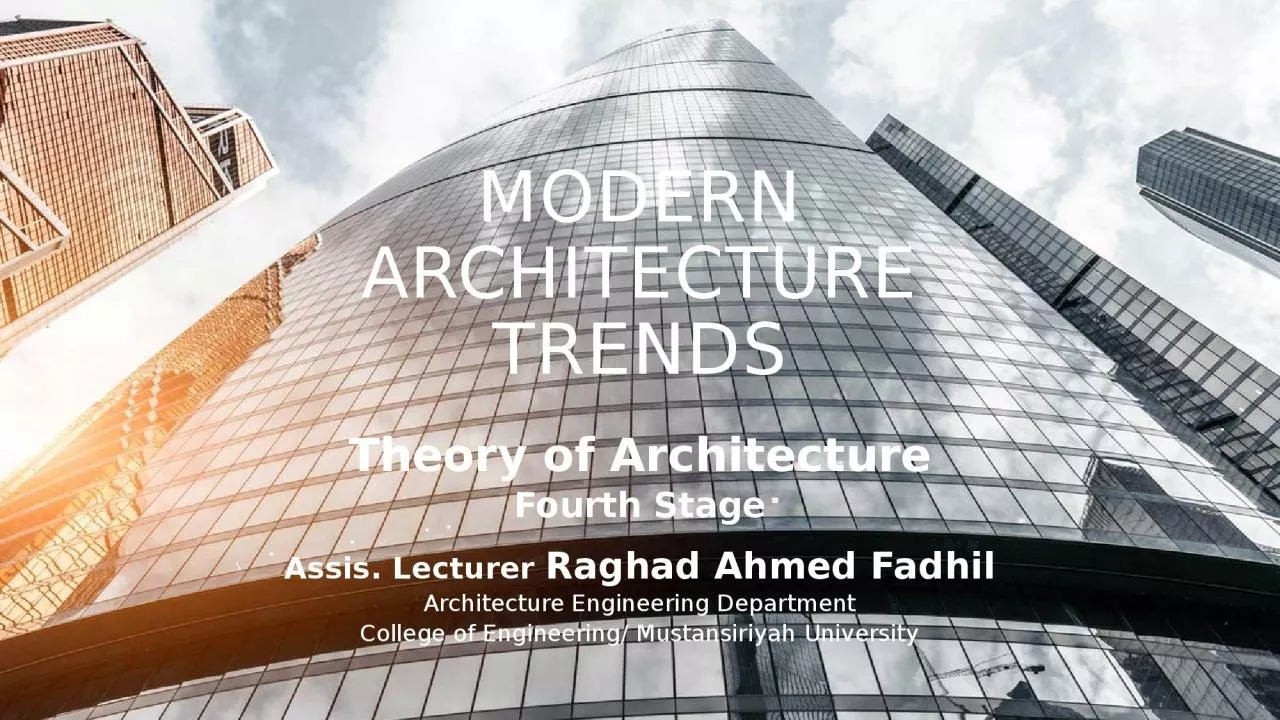

Theory of Architecture Fourth Stage Assis Lecturer Raghad Ahmed Fadhil Architecture Engineering Department College of Engineering Mustansiriyah University Otis is displaying his invention the elevator ID: 1019178
Download Presentation The PPT/PDF document "Modern Architecture Trends" is the property of its rightful owner. Permission is granted to download and print the materials on this web site for personal, non-commercial use only, and to display it on your personal computer provided you do not modify the materials and that you retain all copyright notices contained in the materials. By downloading content from our website, you accept the terms of this agreement.
1. Modern ArchitectureTrendsTheory of ArchitectureFourth StageAssis. Lecturer Raghad Ahmed FadhilArchitecture Engineering DepartmentCollege of Engineering/ Mustansiriyah University
2. Otis is displaying his invention (the elevator)1.Using Machinery2.Mass Production3.Standardization4.The use of new materials(Steel and Glass)5.Invention of the elevator2Industrial Revolution’s main Effects on ArchitectureModern Architecture Trends
3. CircumstancesChicago SchoolChicago School, group of architects and engineers who, in the late 19th century, developed the skyscraper. They included Daniel Burnham, William Le Baron Jenney, John Root, and the firm of Dankmar Adler and Louis Sullivan. Frank Lloyd Wright started in the firm of Adler and Sullivan but created his own Prairie Style of architecture.Chicago's architecture is famous throughout the world and one style is referred to as the Chicago School, also known as 'commercial style'. While the term Chicago School is widely used to describe buildings in the city during the 1880s and 1890s. After the Great Fire of 1871 had left the city’s central commercial district in ruins. 3Modern Architecture Trends
4. PrinciplesChicago School1. The building’s overall form follows the structure of a classic column. Its lower floors act as the base/podium, featuring an exterior that is a bit distinctive from the rest of the buildings—usually incorporating more glass. Its middle floors act as the column’s shaft. And, finally, the top floors act as the capital, crowned with a cornice, and revealing some simple ornaments.2. All buildings utilize a steel-frame structure, allowing more height. The structural steel was manufactured to be fire-proof to avoid catastrophes similar to the 1871 Chicago Fire.3. The buildings are clad in masonry(Terra Cotta), showing little ornamentation and making space for large surface windows.4. The design of the windows followed a system that ensured the entry of both light and ventilation. Those windows are typically repeated all over the building, creating a regular grid. Sometimes, the windows are projected to the outside, creating a bay inside the space, and they are known as oriel windows.4Modern Architecture TrendsThe Home Insurance Building architect William Le Baron Jenneythe first skyscraper in the worldwas built in Chicago in 1885 and was demolished in 1931.
5. Chicago SkyscrapersCarson, Pirie, Scott & Co. Building Chicago, 1899-1904Louis SullivanThe Chicago Building Chicago, 1904-1905Holabird & RocheModern Architecture Trends
6. 6Louis Henry SullivanAn American architect, and has been called the "father of skyscrapers“ and "father of modernism". Sullivan’s work principles:1. the use of arches2. cast-iron ornament inspired by nature.3. sculptural terra cotta.Sullivan is famous with this quote “Form Follows Function”which means “All things in nature have a shape, that is to say, a form, an outward semblance, that tells us what they are, that distinguishes them from ourselves and from each other.” Guaranty Building, New York, 1894Modern Architecture Trends
7. Thank You